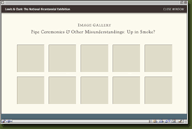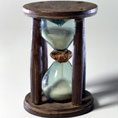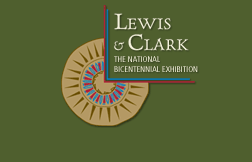
IMAGE GALLERY
 |
 |

Access the Image Gallery to see all images, objects, and documents used in this lesson plan.
 |
View Image Gallery

|

|
 |



Lesson Plan 4: Lewis Goes Shopping
OBJECTIVES
Students will:
- analyze data from primary documents, identify and classify objects needed for the expedition, and draw conclusions
- analyze pictures of artifacts and identify and classify objects based on their observations
MATERIALS
OPENING
 Look at the lists generated in Lesson 1. Ask, "Are there any items that would not have been available in 1803? What categories could you sort the items into?" Cross unavailable items off list. Generate list of categories. Categories could include: tools, medical supplies, food items, Indian presents, military items, lodging items. Note: historians often use the categories of commerce, empire, and science; you may prefer to have students use their own categories for classification or give them categories. Look at the lists generated in Lesson 1. Ask, "Are there any items that would not have been available in 1803? What categories could you sort the items into?" Cross unavailable items off list. Generate list of categories. Categories could include: tools, medical supplies, food items, Indian presents, military items, lodging items. Note: historians often use the categories of commerce, empire, and science; you may prefer to have students use their own categories for classification or give them categories.
PROCEDURE
- Distribute copies of Lewis's List of Requirements to each group. Use dictionaries to identify any unfamiliar items. Lewis has classified items into categories. Students should compare Lewis's categories with their categories.
- Ask, "What ten supplies or items do you think were most important for the success of the expedition? Why?"
Journal writing: Write a journal entry from Lewis's point of view. (You are still on your shopping trip in Philadelphia!) What ten supplies or items do you think will be most important for the success of your expedition? Why?
- Divide the class into cooperative groups of four to five per group with a recorder and a reporter in each group.
- Distribute images of the objects to each group.
- Students should examine each object, look for it on the list, then use a Post-it note to label the picture with its name and use. (Rotate pictures so each group labels each picture.)
- Students will also determine whether each item was to be used by the members of the expedition, or if it was to be given as a present or gift of trade to the Indians.
- Using the image captions, students should identify the place where equipment was manufactured (almost all were made in England). What does this say about the United States at this date? (Economy based on commerce, not manufacturing; really dependent on trade with England)
- N
 otice Lewis's category "Indian Presents." How would Lewis know what to buy for the Indians he would encounter? Teacher asks, "How do you decide on a gift to give someone when you don't know them? What makes a good or appropriate gift? Why did Lewis choose the items he did to give as gifts?" Elicit responses while giving background information about the nature of gifts for the expedition in the teacher reading. It is important to note that Indian gifts were not very different from the "camping equipment." They were not the stereotypical trinkets. Another important point is that Lewis often chose gifts for the wrong reasons: what was available, what he could afford, items he thought Indians ought to want, not what they did want; items he would have wanted. otice Lewis's category "Indian Presents." How would Lewis know what to buy for the Indians he would encounter? Teacher asks, "How do you decide on a gift to give someone when you don't know them? What makes a good or appropriate gift? Why did Lewis choose the items he did to give as gifts?" Elicit responses while giving background information about the nature of gifts for the expedition in the teacher reading. It is important to note that Indian gifts were not very different from the "camping equipment." They were not the stereotypical trinkets. Another important point is that Lewis often chose gifts for the wrong reasons: what was available, what he could afford, items he thought Indians ought to want, not what they did want; items he would have wanted.
Option: The teacher may choose to create a bulletin board with pictures of objects displayed. Each group can place its Post-it on the photographs so all ideas can be shared.
CLOSING
If you were a representative of the American government and were traveling to an area unfamiliar to you, what items would you take along to give as presents to the people you encountered? These items should represent American technology and should be items that are of interest to people.
[PRINTABLE VERSION]
|
 |








